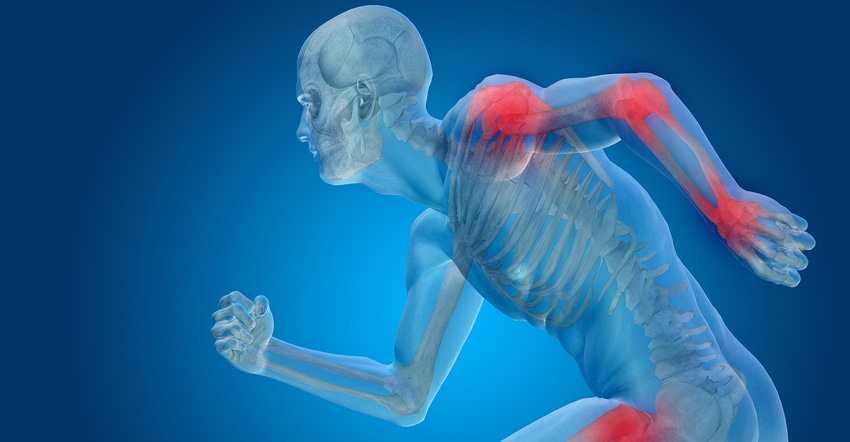Enhancing joint health with innovative ingredients
An aging population and interest in long-term mobility will drive the joint health supplement market to a 6.6% annual growth rate over the next five years. Formulators have a wide range of substantiated ingredients from which to choose to develop innovative joint health supplements.

Mobility goes hand in hand with healthy bones and joints, and is essential for a higher quality of life. Healthy and functional joints help us move and keep us stable. But as the global population ages and longer life spans become a global phenomenon, maintaining a higher quality of life is gaining importance. Joint health, a cornerstone of this endeavor to live healthier, fitter lives, is something that cannot be underestimated.
Years of exercise and aging can take a toll on the joints and result in inflammation, stiffness and various associated conditions including osteoarthritis and osteoporosis, which lead to restricted, increasingly uncomfortable movements.
Fortunately, there are steps consumers can take to enhance their joint health and related mobility and stability. Dietary supplements also have a role to play in maintaining healthy joints and preventing onset of troublesome joint issues. There is a range of ingredients that claim the bone and joint health nutrition benefits.
Glucosamine: A vital component of synovial fluid that protects and acts as a lubricant for the joints, which also slows down cartilage degeneration by generating new cartilage and repairing connective tissue.1
Chondroitin: Another major component of synovial fluid, chondroitin acts as a shock absorber for the joints and reduces the friction1.
Krill Oil: A rich source of the carotenoid astaxanthin, krill’s anti-inflammatory omega-3 fatty acids are in phospholipid form, making them easily absorbable.2
Curcumin: Traditionally used in Ayurvedic medicines for healthy joints, curcumin—which is found in turmeric—has antioxidant and anti-inflammatory properties.3
Methylsulfonylmethane (MSM): MSM is a naturally occurring sulfur compound that supports joint health. It helps relieve pain and swelling associated with mild osteoarthritis, and combining it with other ingredients such as collagen, curcumin, chondroitin sulfate, boswellic acid and others, enhances its functionality in joint-related disorders.4
Hops: Mostly used for making beer, hops (Humulus Iupulus) flowers also have pain-relieving alpha acids.5
Terminalia Chebula: Known as the ‘King of Medicine’, this Ayurvedic plant is known for its fruit’s healing properties throughout South Asia. Studies suggest chebulic supplementation is associated with clinical improvements in stiffness and WOMAC scores besides the decreased need for painkillers.6
Horsetail: Horsetail (Equisetum arvense) may be useful for supplying nutrients that enhance bone and joint health. It is believed to be a bioavailable source of silicon, which plays an important role in connective tissues like bone and cartilage.7
Vitamin D: This fat-soluble vitamin is necessary for protecting joints and bones, and enhancing calcium absorption.8
Boswellia serrata: Acetyl-11-keto-β-boswellic acid (AKBA) present in Boswellia serrata is a potent inhibitor of 5-lipoxygenase—an enzyme responsible for pain and inflammation.9
Ginger: Extracts of members of the Zingiberaceae family such as ginger, galangal and curcumin possess anti-inflammatory properties that offer effective relief from chronic pain.10
Piperine: The key extract in black pepper, piperine’s beta-caryophyllene binds to the receptors that help prevent inflammation.11
Collagen: Collagen accounts for about 30% of the body’s total protein content. Several studies reveal that collagen supplementation reduces collagen damage in the body, a remedy for joint damage and pain and for increasing bone density.12
Hyaluronic Acid: One of the constituents of joints, researchers reported that hyaluronic acid (HA) supplementation significantly improved mobility by reducing pain.13
Formulation considerations
Many joint health products are available to consumers, in various forms including powders, liquids, capsules and more. In addition, there is growing interest in vegetarian options. As noted earlier, herbals, vegetarian alternatives of glucosamine and chondroitin, botanicals and MSM may offer similar benefits to those of traditional joint care ingredients like glucosamine or chondroitin counterparts without animal-source concerns.
When formulating a new product, there are several considerations at hand:
Does the product contain an optimal combination of ingredients to offer sustainable benefits?
Is the product suitable for vegetarians and vegans?
Is it easy to swallow?
What is the potency and absorption?
Is it free from allergens?
Is there equivalence of serving sizes amongst different forms?
What is the duration required to experience effectiveness?
Today’s consumers are increasingly aware of the supplement ingredients and their benefits, and demand products backed by substantial scientific evidence. Moreover, they are on the lookout for supplements that offer multiple benefits. To make the most of this opportunity while bringing value to the consumers, brand owners need to work with their manufacturer and adopt innovative dosage forms for effective delivery of multiple ingredients, delayed release and enhanced bioavailability.
Catering to one of the primary concerns of the longer-living global citizens—joint health and preventive joint health care for enhanced mobility—offers great potential. In fact, the aging baby boomers are growing in numbers and so are the age-related lifestyle health issues, which Mordor Intelligence expects to propel the bone and joint health supplement market towards a 6.6% compound annual growth rate (CAGR) between 2019 and 2024. Posing challenges and paving the way for today’s supplement brand owners, these are opportunities (that can’t be missed) for creating innovative joint care formulations with fast, long-lasting and multiple benefits.
Andrew M. Goldman currently serves as the vice president of digital marketing for NutraScience Labs, a business-to-business provider of turnkey contract manufacturing services. In his role, Goldman leverages his 15 years of nutraceutical industry and inbound marketing experience to develop content for dietary supplement brand owners and inbound marketing strategies. Andrew lives in South Florida with his wife, two children and two dogs.
References:
1. Jerosch J. “Effects of glucosamine and chondroitin sulfate on cartilage metabolism in OA: Outlook on other nutrient partners especially omega-3 fatty acids.” In J Rheumatol. 2011. http://dx.doi.org/10.1155/2011/969012.
2. Ierna M et al. “Supplementation of diet with krill oil protects against experimental rheumatoid arthritis.” BMC Musculoskelet Disord. 2010;11:136.
3. Chin KY. “The spice for joint inflammation: anti-inflammatory role of curcumin in treating osteoarthritis.” Drug Des Devel Ther. 2016;10:3029-42.
4. Butawan M, Benjamin RL, Bloomer RJ. “Methylsulfonylmethane: Applications and safety of a novel dietary supplement.” Nutrients. 2017 Mar;9(3):290.
5. Lerman RH et al. “Nutritional approach for relief of joint discomfort: A 12-week, open-case series and illustrative case report.” Integr Med (Encinitas). 2015 Oct;14(5):52-61.
6. Seo JB et al. “Anti-arthritic and analgesic effect of NDI10218, a standardized extract of Terminalia chebula, on arthritis and pain model.” Biomol Ther (Seoul). 2012 Jan;20(1):104-12.
7. Dragos D et al. “Phytomedicine in joint disorders.” Nutrients. 2017 Jan;9(1):70.
8. Manoy P et al. “Vitamin D supplementation improves quality of life and physical performance in osteoarthritis patients.” Nutrients. 2017 Aug;9(8):799.
9. Bertocchi M et al. “Anti-Inflammatory Activity of Boswellia serrata Extracts: An In Vitro Study on Porcine Aortic Endothelial Cells.” Oxid Med Cell Longev. 2018:2504305.
10. Lakhan SE, Ford CT, Tepper D. “Zingiberaceae extracts for pain: a systematic review and meta-analysis.” Nutr J. 2015;14:50.
11. Bang JS et al. “Anti-inflammatory and antiarthritic effects of piperine in human interleukin 1β-stimulated fibroblast-like synoviocytes and in rat arthritis models.” Arthritis Res Ther. 2009;11(2):R49.
12. Dar QA et al. “Daily oral consumption of hydrolyzed type 1 collagen is chondroprotective and anti-inflammatory in murine posttraumatic osteoarthritis.” PLoS One. 2017;12(4):e0174705.
13. Nicholls MA et al. “The disease-modifying effects of hyaluronan in the osteoarthritic disease state.” Clin Med Insights Arthritis Musculoskelet Disord. 2017. DOI:10:1179544117723611
About the Author(s)
You May Also Like






.png?width=800&auto=webp&quality=80&disable=upscale)